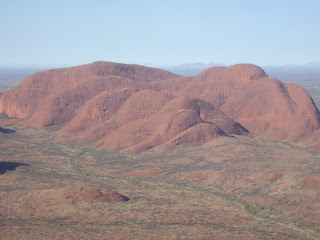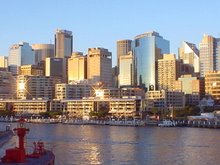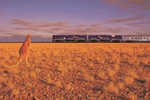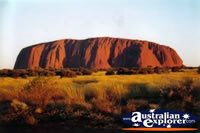Sept 23
Planes, trains, campers, buses, helicopters, cars, boats. See Australia! We’ve done it all. Now it's back to a train for the 1000 mile, 25 hr. trip from Cairns to Brisbane, along the Queensland coast. Incidentally, the golfer, Greg Norman, known as the Great White Shark, is from Queensland. Was reminded of this by an Aussie tabloid story about his former wife’s bitter feelings about Chris Evert, the tennis player, who stole her man. I didn’t know that happened.
The Tilt Train is sleek, quiet, and smooth-riding. The seats are comfortable and versatile and the windows are large. There are even electrical outlets so that I can plug in the very computer on which I am now writing. No wireless, though. It doesn't have sleepers or a dining car -- there's a snack bar car and it sells airline types of meals.
The train, which is called the fastest narrow gauge train in the world (though narrow gauge here is not what it is in the US), is capable of speeds up to 100 mph. It won’t do this on our trip, it turned out, due to technical problems. In the first two-thirds of the trip there are too many unprotected intersections for that sort of speed. One wonders why the problem intersections have not been upgraded or eliminated. Nice lady tells us the government is foot-dragging. The Train mag notes that the TT was just extended to Cairns in 2003, though from what point south I don’t know, so that’s not a lot of time for designing and building new intersections. We had hoped for some high speed later in the trip, even though it would be after dark, but, as noted, it didn’t happen. Anyway, still a nice and interesting trip.
We start out passing through sugar cane fields – herewith starts a km by km report on the trip (just kidding). We stop at a station about every 30 mins. We soon see some tropical-looking trees with bags hanging from them and wonder what they are. Nice man explains they are banana trees; the bags are protecting developing bunches. Just tie ‘em off and ship them to the grocers.
On the topic of sugar cane, Dick was intrigued by the machines used to harvest cane and on the drive from Dan’s to dinner, the evening before, we pulled off the road so he could get a picture, and by good fortune, talk to the cane farmer about it. Turns out this cane harvester was manufactured in Louisiana. Next year’s version will be green because the company now belongs to John Deere. Here's a picture of an Iowa corn grower interrogating a Queensland cane grower.

One other point: They get one crop of cane a year and three years of production by sugar cane plants before they plow them under and start another three-year cycle.
Back to the liveblog: Three or four hours later the countryside transitions into much dryer, fairly barren pasture land. The mountains that had been on our right are gone. Brahma cattle, which we’ve been told do well in tropical climes, are seen. Isn’t this exciting! The pastures seem to have suffered from a combination of drought and overgrazing. Next to the track the grass is much lusher than in the pastures.
Oops, now we’re back into sugar cane. Maybe we’re going the wrong way! This train has a backward facing engine on its back end. They pushed the wrong button! Never mind. Think I’ll drop the running report and go tidy up earlier reports and get them ready for posting, some day, somewhere.
4:12pm. Just crossed a river.
Night: Now it’s dark.
I don’t sleep much. Watch a couple of movies. Read some Robinson Crusoe. This is my second shipwreck and survival book on this trip. The first was The Narrative of Arthur Gordon Pym of Nantucket, by Edgar Allan Poe, both from my Paul Theroux-inspired reading list. I think Theroux liked Poe's book because it was the ultimate trip gone bad story. Top ten things you don't want to happen on a sea voyage.
After one long chapter of Crusoe I decide I’ve had enough of the high seas for now. I have paid ample homage to historic English literature (endured long, ornate sentences) and so I switch to The Confederacy of Dunces, the funniest book I’ve ever read. (I will go back and finish Robinson Crusoe -- it is interesting and more than just an adventure story.)
Confederacy is a Pullitzer-prize winner that my book club did several years ago and I decided it was time for a re-read. Walker Percy, who wrote a really clever and to the point introduction (that you should not avoid reading), said he was astounded more on his third reading than on his first, which blew him away.
Confederacy is an example of a one-book phenomenon, tragically in this case. The author, John Kennedy Toole, committed suicide before the book was published. In fact the reason the book was published was because Toole’s mother implored Percy to read it several years after her son's death – she knew it was a great book. Oh, sure, he thought, but as he finally read it, after her repeated urging, he was hooked.
It’s morning, now. Dick reports success – he just saw a real live wallaby in the wild. Up to now it had just been a couple of road-kill kangaroos that I saw and Dick didn’t. A little bit later we both see wallabies, or maybe kangaroos – these are large fellas: size is the main distinction between wallabies and kangaroos -- near the track. Now we can go home with no unfulfilled expectations.
I also saw this prominent mountain along our route this morning. It was one of several such outcroppings along the way. Can't find any mountain names on my most detailed map.

We arrive in Brisbane an hour late, but still with several hours to occupy before we fly to Sydney. We’d left several hours between arrival and departure from Brisbane either to see some of Brisbane – check it off our life list – or to allow for major train delays. So, we took a city-sights bus tour. It was a good tour, driver drove his bus like a sports car, and gave me a good feel for the city.
Here are a couple of pix. Brisbane is the largest Australian city in area, and the third or fourth largest in population (Dick and I remember both Perth and Brisbane claiming third place after Sydney and Melbourne). You could look it up. The building below is former train station.


We fly on to Sydney for the night en route to flight home the next day.
Cheers,
Rob

























 Cheers,
Cheers,











